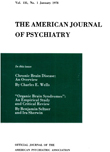Diagnosis: schizophrenia versus posterior aphasia
Abstract
Schizophrenia and posterior aphasia are easily cross-diagnosed, primarily because of similarities in verbal output, i.e., vagueness, looseness of association, and apparent confusion. Tape-recorded interviews with 8 posterior aphasics and 10 "loose" schizophrenics were transcribed and analyzed to provide guidelines for the clinician to differentiate the two conditions by monitoring verbal expression. Six major differentiating characteristics were identified. The authors present hypotheses that emphasize differing neuroanatomical loci and neuropsychological mechanisms to explain the differences in verbal output in schizophrenia and posterior aphasia.
Access content
To read the fulltext, please use one of the options below to sign in or purchase access.- Personal login
- Institutional Login
- Sign in via OpenAthens
- Register for access
-
Please login/register if you wish to pair your device and check access availability.
Not a subscriber?
PsychiatryOnline subscription options offer access to the DSM-5 library, books, journals, CME, and patient resources. This all-in-one virtual library provides psychiatrists and mental health professionals with key resources for diagnosis, treatment, research, and professional development.
Need more help? PsychiatryOnline Customer Service may be reached by emailing [email protected] or by calling 800-368-5777 (in the U.S.) or 703-907-7322 (outside the U.S.).



